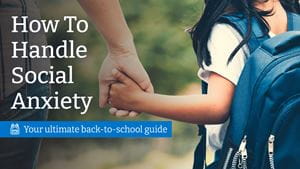
Over the last year, millions of children across the United States went through a period of intense change during the COVID-19 pandemic with hybrid learning, adjusted schedules for sports and arts programs, and a host of other big shifts in their lives.
Now that a new school year is beginning, school districts are planning to bring students back to school in-person - which may trigger anxiety for children for a number of reasons. Parents and school staff alike are preparing when classes resume in September.
We asked Cassandra Berbary, PhD, a psychologist with Rochester Regional Health who works with children, for advice on how to approach conversations about anxiety with your children.
Social anxiety is related to social situations involving interaction with a group of people, while separation anxiety is related to being apart from family, parents, or caregivers.
Some children might experience separation anxiety because they have been home so much more often since March 2020 when the COVID-19 pandemic began to spread in the U.S.
There are always some children who have anxiety about going back to school. But experts are expecting to see more cases of children this fall whose anxiety is compounded by other factors.
“There’s a chance that maybe they weren’t in-person at school at all last year or maybe they were doing a hybrid approach,” Dr. Berbary said. “Kids might not only be anxious about returning to school and that change in their routine, but anxious and worried about safety in general.”
Another important reminder for families, according to Dr. Berbary, is that children living through a global pandemic is something we haven’t dealt with before.
“I think compared to years past, we’re going to be seeing more kids who are experiencing anxiety as they move back toward what our new normal is,” Dr. Berbary said.
The ones who will be seeing those first signs of anxiety will be the parents and caregivers of children. As those initial lines of defense, talking openly and honestly should be a priority. This helps to let their child know they are safe and as prepared as they can be. Part of that discussion means listening to their fears and concerns – and validating them.
“I don’t think parents can promise kids that things won’t change again because we don’t know that for sure,” Dr. Berbary said. “But parents can let kids know that all the adults around them are working to make sure that they are safe.”
If you are looking for a place to start in having conversations with your child about social anxiety and returning to school, here are some ideas to help:
Stay calm: When a child looks to an adult for help with anxious feelings, it might be more difficult for the child to overcome those feelings if the adult is anxious too. Keeping a calm demeanor while validating a child’s feelings can be key.
Set a routine: Consistency can be comforting. Establishing a routine both at home and school is something your child can rely on. Work together to create one for before school and after returning home from school. For younger kids, doing this in picture form is helpful. Older kids can have a list of what to do and when.
Communicate with trusted adults: Especially for younger children, it is important to know they can have an adult in whom they can trust and confide. Laying the foundation early in their life can give them more stability as they grow up.
Different ideas work for different age groups. The expectations of a second-grade student will not be the same as the expectations of a tenth-grade student, so it makes sense to focus your conversations accordingly.
Younger children want to know what to expect. To help them, focus on the routine that will outline their day. This can include what the school bus, building, and classroom will look like, which people they might see when they arrive, what activities they will be doing, and all the safety rules that people will be following.
For adolescents and teenagers, there will likely be more focus on details. It is important to give them accurate responses to those more detailed questions without overwhelming them with information and adding to their anxiety, Dr. Berbary suggests.
By including them in some of the decision making surrounding their school routine, older children can begin to develop a sense of responsibility and autonomy. These are ultimately good life skills to practice and can help with problem solving and adapting to change.
Give your child some time to adjust to school as a new part of their life. As the first few days become the first few weeks, settling into that new routine might lessen their anxiety.
For some children, the time may not make the anxiety easier to handle.
Dr. Berbary encourages parents and caregivers to seek out a professional to help when their child may be: